We have to start somewhere so let’s start on the winter solstice which is the shortest day of the year and very frequently the coldest. I’m talking midwinter when the sun is at the lowest it ever gets in the sky and because it has significantly reduced eastern and western access to any home, and therefore the day is shorter, there is less time for the sun to warm your home up in the winter just when you need it. The plan is therefore to maximise sun exposure into the home and access the sun’s heat to warm the home ready for the cooler evening that always follows.
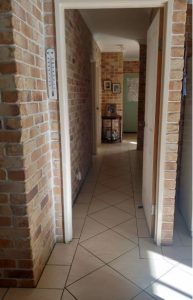 On the winter solstice there has been 6 weeks of winter already experienced and there remains another 6 weeks of winter. Temperatures are generally at their lowest at this time of the year. As a rule, the greater your locational distance from the Equator and the higher your altitude, the greater the temperature variation between the seasons. Living in an energy efficient home uses mother nature to reduce the extreme temperature fluctuations with the your home. There are a number of advantages as to why you would want to live in an energy efficient home including greater thermal comfort and reduced energy bills. If we focus on the performance of an energy-efficient home in the wintertime, factors that play together, like well-played instruments in an orchestra, deliver the beautiful symphony of a more pleasant thermal environment inside the home when the home is engulfed in a typical winter’s day.901.
On the winter solstice there has been 6 weeks of winter already experienced and there remains another 6 weeks of winter. Temperatures are generally at their lowest at this time of the year. As a rule, the greater your locational distance from the Equator and the higher your altitude, the greater the temperature variation between the seasons. Living in an energy efficient home uses mother nature to reduce the extreme temperature fluctuations with the your home. There are a number of advantages as to why you would want to live in an energy efficient home including greater thermal comfort and reduced energy bills. If we focus on the performance of an energy-efficient home in the wintertime, factors that play together, like well-played instruments in an orchestra, deliver the beautiful symphony of a more pleasant thermal environment inside the home when the home is engulfed in a typical winter’s day.901.
Whilst there are most certainly homes that thermally perform better than my family’s home, I will use our 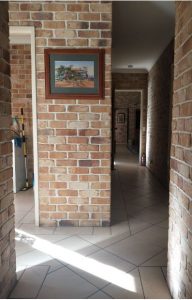 home to showcase what design factors need consideration are why they need consideration for a home to thermally perform well on a cold winter’s day.
home to showcase what design factors need consideration are why they need consideration for a home to thermally perform well on a cold winter’s day.
These photographs were taken in 2021. Our home is located about an hour north of Brisbane, Queensland, Australia, having a latitude of 27 degrees south. On our property, the sun rises above the trees to the north of our home as late as 8:50 in the morning on this day.
We live in a valley surrounded on all sides by hills. The topography of the environment where our home is located, as in any location has advantages and disadvantages. With an even bigger hill to the west of our home, the sun sets prematurely at 3:15 p.m. on this shortest day of the year. The days are short in the wintertime, but, as will become self-evident, our home has been designed and built to get the maximum benefit that the sun can possibly deliver at this location on every day of the year.
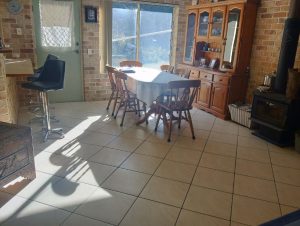 When the sun finally rises high enough to clear the northern tree line, it will be near full strength on a clear day. As on any day, it will increase in strength until just after midday and then will reduce in strength until it sets. It will not have the same intensity as on the summer solstice (ie. the longest day of the year) however, because our home has been well designed, achieving the highest NatHERS Star Rating at the time, (BERS Rating 9+ in 1999), it is very comfortable inside the home on those cold winter days. The week after these photos were taken we had a few frosty days. The first frost was the most significant and covered the ground as high as 60 m up the northern hill at the back of our home. For ice to be formed it must be at least as cold as minus 4 degrees Celsius long enough to freeze the dew. Whilst the ground temperature at our location is 23 degrees, temperatures inside our home will drop below that when we get extended cold spells. It has been as low as 12 degrees inside the home after extended cold weather however it generally performs, as was computer modelled before construction, to stay around the 17 degrees Celsius mark at this time of the year. This is much more comfortable than any of the outside temperatures at this time of the year. I probably should add here that the major complaint my wife has with our home is that we spend less time outside now than we did at our previous location because temperatures inside our home are always more comfortable than those outside.
When the sun finally rises high enough to clear the northern tree line, it will be near full strength on a clear day. As on any day, it will increase in strength until just after midday and then will reduce in strength until it sets. It will not have the same intensity as on the summer solstice (ie. the longest day of the year) however, because our home has been well designed, achieving the highest NatHERS Star Rating at the time, (BERS Rating 9+ in 1999), it is very comfortable inside the home on those cold winter days. The week after these photos were taken we had a few frosty days. The first frost was the most significant and covered the ground as high as 60 m up the northern hill at the back of our home. For ice to be formed it must be at least as cold as minus 4 degrees Celsius long enough to freeze the dew. Whilst the ground temperature at our location is 23 degrees, temperatures inside our home will drop below that when we get extended cold spells. It has been as low as 12 degrees inside the home after extended cold weather however it generally performs, as was computer modelled before construction, to stay around the 17 degrees Celsius mark at this time of the year. This is much more comfortable than any of the outside temperatures at this time of the year. I probably should add here that the major complaint my wife has with our home is that we spend less time outside now than we did at our previous location because temperatures inside our home are always more comfortable than those outside.
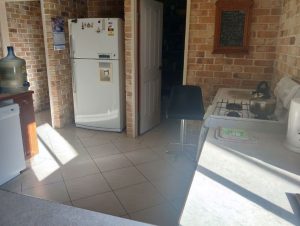 All of the pictures shown here were taken within a few moments of each other and knowing that the long side of the house is approximately 11 degrees east of magnetic north, it is clear that the sun is coming from the north east in the early part of the morning.
All of the pictures shown here were taken within a few moments of each other and knowing that the long side of the house is approximately 11 degrees east of magnetic north, it is clear that the sun is coming from the north east in the early part of the morning.
Picture 1. is looking from our kitchen to the western side of the house down our hallway and it is clear to see that the sun is penetrating into the house almost halfway of its width.
Picture 2 is a shot back the other way looking to the east of the home and the sun enters the home through the laundry window. There is also reflected light from a large mirror in the bathroom at that end of the home. If you look carefully using the floor tiles as a guide, you will note that at both ends of the hallway the sun can be seen to penetrate equally as far into the home. This means that the home is perfectly orientated for the sun to flood through the windows at this time of the year and that our home gets the maximum heating benefit possible.
Picture 3 shows the sun access into our dining room. As the day progresses, the sun’s warmth will heat up the tiles, bricks and furniture that it shines on as it moves across the room. Pictures 4 and 5 show early sun access in the kitchen area on the winter solstice. This pattern is repeated at the same time on this day every year. The sun is only denied access into the home at this time should the weather be overcast.
At our location, the ground temperature is a fairly stable 23 degrees and therefore Mother Nature is working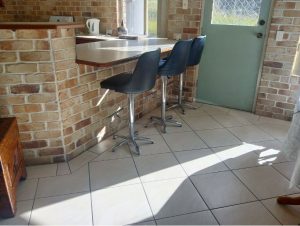 24-hours a day seven days a week to keep the ambient temperature inside our home at 23 degrees. She is not always successful but her efforts are significant requiring little auxiliary energy input if any to keep the internal ambient temperature in what I call “The Sweet Spot”.
24-hours a day seven days a week to keep the ambient temperature inside our home at 23 degrees. She is not always successful but her efforts are significant requiring little auxiliary energy input if any to keep the internal ambient temperature in what I call “The Sweet Spot”.
There are 27 700 bricks in our home. Bricks have high thermal mass which means they don’t change their temperature quickly. The second law of thermodynamics dictates that temperature of the bricks in our home and the ambient temperature inside our home will be the same. That’s good for us, who want to have comfortable and stable inside temperatures because as the bricks are supplied with heat from the sun shining on them, or they gain heat transferred from the ground, it takes time for them to heat but it also takes time for them to dissipate that heat. They slowly heat up through the day when temperatures are warmer and they slowly radiate that heat back into a cooler ambient temperature through the night which stabilizes the internal ambient temperatures thereby reducing extreme temperature fluctuations in the home.
Seriously it doesn’t get any better.
Build, buy or rent a thermally stable home.
They are much more comfortable to live in and not just in the wintertime.
End The Advantages of Living In An Energy Efficient Home Part 1
Get your FREE copy of “Savvy Up and Save” here >>>LEARN MORE>>>
Moreton Bay residents can access weekly tips from John on Community Radio 101.5 FM Friday Mornings at 10:10am
John Lynn
